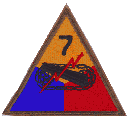

Belsen Concentration Camp was visited May 1, 1945 (liberated April 15 by British 11th Armoured Division) by members of 31st Tank Battalion. The 31st Tank Battalion Unit History for May 1945 contains the following remark:
|
A number of officers and men during the remainder of the morning paid informal visits to the concentration camp at Belsen now under control of the British. The simple statement on a closed grave 'Approximately 1000 persons Buried Here, April 27, 1945' gives some indication of the condition in which the camp was found. |
Five photographs taken by these men were published in volume II of the "Lucky Seventh", compiled in 1986 and copyrighted in 1987 by the 7th Armored Division Association. These photographs may be viewed below.
|
Here is the basis of our Christian recognition of guilt in consideration of what happened. We did not recognize the Lord Christ when he came into our lives in the form of a suffering brother. I didn't recognize him when he was put in the camp as a Communist, nor did I recognize him, when he was murdered as an incurably ill person, nor did I recognize him when he was gassed and burned as the poor victims of his own [Jewish] people. Here I became guilty in my very personal responsibility and I cannot excuse myself, neither before God, nor before humanity. -- German Pastor Martin Niemöller in 1946 - he himself was eventually arrested by the Nazis and spent 4 years in the Dachau Concentration Camp (source: Die politische Verantwortung des Christen im akademischen Stand : Vortrag gehalten auf Einladung der evangelischen Studentengemeinde vor Studierenden der Philipps-Universität zu Marburg an der Lahn am 4. Mai 1946 / Martin Niemöller. Giessen: W. Schmitz, 1946. 23 p., as quoted in Reden 1945-1954. Darmstadt: Stimme-Verlag, 1958, pp. 45-54, 87ff, with modification of bracketed remark) - also see |
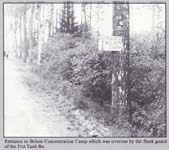
Road to the camp, with sign in English |
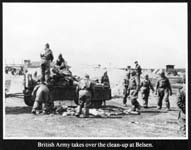
British, in safe suits, loading bodies on cart (typhus and lice were rampant) |

Unloading bodes |
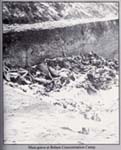
Mass grave |
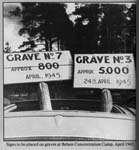
Signs to be placed on graves |
This is a 7 minute silent video clip (with added musical background), showing the first cleanup of bodies in the first of the mass graves that held tens of thousands of bodies. It was one of these graves to which the 31st Tank Battalion After Action Report was referring. Nevertheless, there were so many dead that the cleanup was still going on 2 weeks later when 7th Armored Division arrived and took the photographs shown above.
This is a 1.5 minute silent video clip, showing conditions in the camp and the British after recently arriving and seeing all the unburied bodies
This is a 8 minute video about the British liberators, with interviews and background information [Note that the date of liberation is erroneously given as April 29.] This is the first part of a longer presentation, that is cut off abruptly at the end. - second part - third part (each about 8 minutes).
Among the occupants of Bergen-Belsen by the time that 7th Armored Division arrived there was a large contingent of Hungarian Jewish women who had earlier been held at the concentration camp at Walldorf, Germany -- just south of Frankfurt and just north of the Frankfurt Airport. In fact, the women were used as laborers to work on repairing and extending runways at the airport. 7th Armored Division never went anywhere close to this camp. But since they did cross paths with the occupants of this camp and since Frankfurt Airport is a major destination for arrivals from the United States, you may want to consider visiting this camp if you fly into or out of Frankfurt. It was not re-discovered until 1972 but now has markers along a walking route, which includes the excavated kitchen area, where women were brutally beaten in the kitchen basement area.
Here are some links to information about this camp. http://www.kz-walldorf.de/
Active overview of all pages at the 7th Armored Division web site